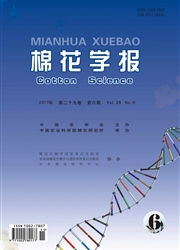

 中文摘要:
中文摘要:
以抗草甘膦陆地棉突变体(R1098)为父本,通过广泛地测交筛选获得高优势的抗草甘膦杂交棉新组合——浙杂14。对河南、安徽和浙江三个制种点6批次的浙杂14杂交棉种子分别进行发芽试验和苗床试验,并用30mL·L^-1的草甘膦溶液进行纯度鉴定。苗期纯度鉴定结果表明,三个制种点6批次的浙杂14种子纯度分别为91.7%、92.4%、77.7%、81.6%、85.6%和86.6%,发芽试验鉴定的纯度结果略低于苗期鉴定,但趋势完全相同,因此这两种方法均可进行该杂交组合种子纯度鉴定。不同纯度杂交棉种子的生产试验结果表明,在一定范围内,杂交棉的皮棉产量与其种子纯度呈正相关,用草甘膦去除假杂种后,可显著增加皮棉产量,并对纤维长度、纤维整齐度和纤维比强度有明显改良作用。
 英文摘要:
英文摘要:
An excellent hybrid cotton cultivar with glyphosate resistance trait, Zheza 14, was obtained by the testing and screening widely for the crosses a somatic glyphosate resistance mutant (R1098) with other upland cotton cultivars or lines. Six different resource hybrid seeds of Zheza 14, from Henan, Anhui and Zhejiang Provinces, were tested for the seed purity, using the method of seed germination and seedling identification with the 30 mL · L^-1 glyphosate solution. As the results of seedling identification, the purity of hybrid seeds from Henan Province was the best, with the purity rate of 91.7%-92.4%, next was that from Zhejiang Province with a seed purity of 85.6%-86.6%, and that from Anhui Province was the worst and the seed purity rate was only 77. 7%-81.9%, although the parent seeds were the same. The results of the seed purity judgment tested by the seed germination method were slightly lower than that of seedling identification, but the tendency of both results was extremely alike, which illustrated that the seed germination test method could be used as the fast judgment for the hybrid seed purity. The field experiment for the different purity rate of the hybrid seeds shown that there was a significant correlation between the seed purity and the lint cotton yield, the glyphosate treatment could increase the seed purification and its yield, as well as the fiber quality, especially for the staple length, fiber uniformity and fiber strength. In addition, the results shown that the seed purity rate for the upland cotton hybrid should be higher than 90%, otherwise the lint cotton yield and fiber quality will be affected greatly.
 同期刊论文项目
同期刊论文项目
 同项目期刊论文
同项目期刊论文
 期刊信息
期刊信息
